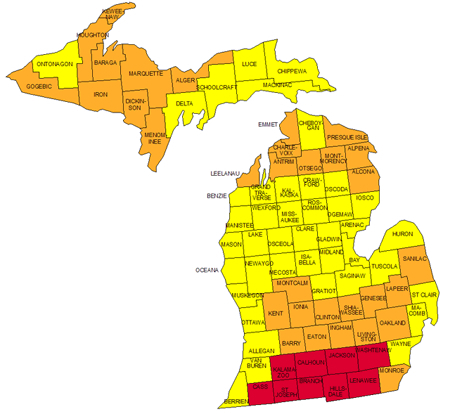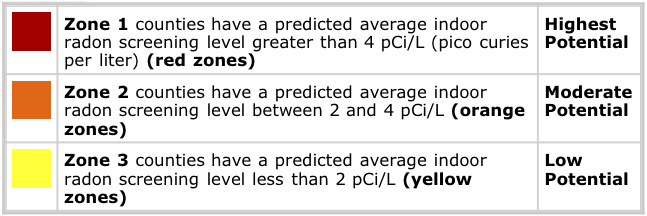Is The Number 2 Cause Of Lung Cancer Creeping Around
Your Home?
Protect Your Family And Yourself With One Phone Call!
Solid Rock Inspections Radon Hotline
Call Us at 248 867 5842
Is It Really As Bad As The News Stories Say?
According to the U.S. Surgeon General and the Environmental Protection Agency, radon is the second leading cause of lung cancer in the United States, responsible for over 20,000 deaths
annually.
Even if you have never smoked a cigarette in your life, if you are consistently exposed to elevated levels of radon over a long enough period of time, you can develop lung cancer.
If you smoke and your home has an elevated amount of radon, your risk of lung cancer is exceptionally high.
Radon gas decays into radioactive solid particles that get trapped in your lungs when you breathe. As the particles break down further, they release small bursts of energy that can damage lung tissue
and lead to lung cancer.
Two things are important to remember. First, not everyone exposed to elevated levels of radon will develop lung cancer.
Second, the amount of time between exposure and the onset of disease may be many years.
Radon level if you have never smoked.
| Radon Level | If 1,000 people who never smoked were exposed to this level over a lifetime*... | The risk of cancer from radon exposure compares to**... | WHAT TO DO: |
| 20 pCi/L | About 36 people could get lung cancer | 35 times the risk of drowning | Fix your home |
| 10 pCi/L | About 18 people could get lung cancer | 20 times the risk of dying in a home fire | Fix your home |
| 8 pCi/L | About 15 people could get lung cancer | 4 times the risk of dying in a fall | Fix your home |
| 4 pCi/L | About 7 people could get lung cancer | The risk of dying in a car crash | Fix your home |
| 2 pCi/L | About 4 people could get lung cancer | The risk of dying from poison | Consider fixing between 2 and 4 pCi/L |
| 1.3 pCi/L | About 2 people could get lung cancer | (Average indoor radon level) | (Reducing radon levels below 2 pCi/L is difficult.) |
| 0.4 pCi/L | (Average outdoor radon level) | ||
| Note: If you are a former smoker, your risk may be higher. pCi/L (pico Curies per Liter) * Lifetime risk of lung cancer deaths from EPA Assessment of Risks from Radon in Homes (EPA 402-R-03-003). ** Comparison data calculated using the Centers for Disease Control and Prevention's 1999-2001 National Center for Injury Prevention and Control Reports. |
What Is Radon?
Radon is simply a gas. It is colorless and odorless… but it is radioactive.
How?
Uranium is a natural element in soil, rocks and water. As it breaks down (decays), it releases radon into the air.
It can get into any kind of building, but people typically face their greatest exposure risk at home.
Does Michigan Have A Radon Problem?
Michigan, like every other state, has homes and buildings where radon is at an unsafe level.
In fact, the EPA estimates that as many as 1 in 15 homes have elevated annual radon levels. Of course, that means most homes do not have a problem.
The EPA analyzed Michigan county-by-county and came up with the following radon level analysis:
Is Testing Expensive?
No, at $125, testing is quite affordable. If your radon test is a part of a Solid Rock Inspections house inspection, the price is even lower—$100!
Do Elevated Radon Levels Mean I Have A “Bad” House?
The presence of radon is not a reflection on the quality of the house.
Radon moves up through the ground to the air above. Since air pressure inside a home is (usually) lower than pressure in the soil around the foundation, the house acts like a vacuum and draws radon
in through any opening… dirt floors, hollow-block walls, cracks in the foundation floor or walls, and openings around floor drains, pipes and sump pumps.
Any house may have a radon problem. This includes new, old, well-sealed or drafty homes, and homes with or without basements. Radon is generally more concentrated at lower levels, like basements,
ground floors and first floors.
Say There Is A Radon Problem… Will It Cost An Arm and a Leg To Get Rid Of The Problem?
Good news—radon mitigation is affordable!
How Is Radon Measured? What Is Normal? What Is Too High?
Radon is measured in picoCuries per liter (pCi/L) of air. A picoCurie is a measure of the amount of radioactivity of a particular substance, and is equal to the decay of about two radioactive atoms
per minute.
The level of radon in outdoor air is about 0.4 pCi/L, and the average indoor radon level is about 1.3 pCi/L.
The EPA has established 4.0 pCi/L as the action level for radon in homes, schools and workplaces.
To put this in perspective, a house having 4 pCi/L of radon has about 8 or 9 atoms of radon decaying every minute in every liter of air inside the house. That means a 1,000 square foot house with 4
pCi/L of radon has nearly 2 million radon atoms decaying in it every minute.
Radon is a Class A carcinogen, so no level is completely risk-free, but it is a natural part of the environment, there is no such thing as a "0" radon level.
It Isn’t A Problem At My Neighbor’s House… Why Would It Be A Problem At My House?
Homes that are next to each other can have different indoor radon levels.
In fact, one of the highest levels ever found in a home (>3,000 pCi/L) was across the street from a home which measured less than 4 pCi/L. Testing is the only way to be certain.
Test Before and After Renovations
If you are planning any major renovation, such as converting an unfinished basement area into living space, it is especially important to test the area for radon before you begin the
renovation.
If your test results indicate a radon problem, radon-resistant techniques can be inexpensively included as part of the renovation.
Also, remember that major renovations can change the level of radon in any home, so the EPA recommends you have your house tested again after the renovation work is completed.
Why Should I Have Solid Rock Inspections Test For Radon?
Solid Rock inspectors are certified in radon testing, and certified in radon mitigation.
What If My House Or Building Has Elevated Radon Levels?
The good news: radon mitigation is affordable. Even high levels can be reduced to acceptable levels in most cases.
There are two approaches to radon mitigation or reduction. One is to prevent the radon from entering the structure and the other is to remove the radon after it enters the structure. Generally, the
best approach is to prevent the radon from entering.
If there is an issue, we will review your options, and refer you to a qualified contractor, such as our sister company, SRI Construction, to mitigate the radon.
Solid Rock Inspections Radon Hotline
Call at 248 867 5842






